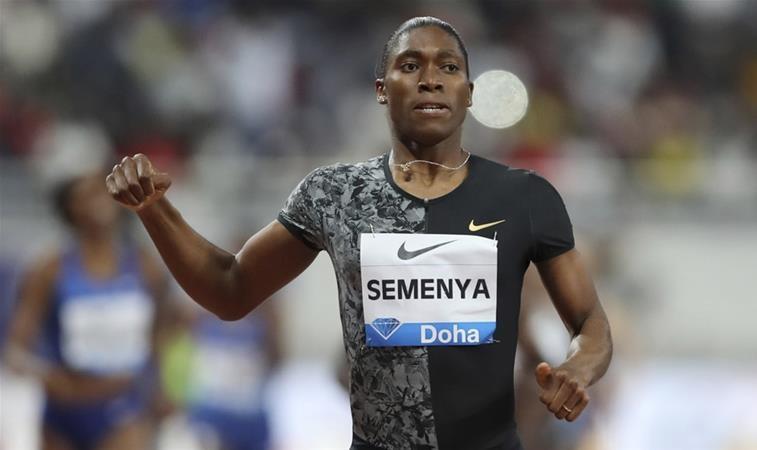Caster Semenya, 10 years of controversy about her gender: “Take a good look, for me this is not a woman”

Mokgadi Caster Semenya, an athlete from South Africa! In the summer of 2009, she shot at the athletics firmament like a comet. Since then it has never been quiet around the South African athlete. She collected titles and medals quickly, but the cheers rarely sounded unison.
Last night, Semenya took the 800-meter mark at the Diamond League race in Doha (win). Her last race, before the hyperandrogenic athlete has to take the pills again to keep her testosterone levels under control. A look back at ten years of controversy around her gender.
July 31, 2009, when Caster Semenya hits the athletics world for the first time with silence. She is eighteen when she wins the 800 meters in the African youth championships in 1: 56.72. Not only the best world time but also a crushing of her personal record with almost four (!) Seconds. Eyebrows frown, experts express their doubts.
Three weeks later, Semenya rushed to gold at the World Cup in Berlin with a new best world year performance (1: 55.45). Number two and three, the Kenyan Janeth Jepkosgei and the British Jenny Meadows, are not in the photo. “Take a good look at this person,” fills the Russian Maria Savinova, disappointingly fifth in the final. “This is not a woman for me. I feel so bad for the other athletes. It is useless to fight such a person. This is not fair.”

At the International Athletics Federation (IAAF) they are bored with the situation. Secretary-General Pierre Weiss does not bother: “Caster Semenya is a woman, but perhaps not 100 percent.” Mysterious words, but what turns out? The IAAF did not sit still during the weeks before the World Cup. Semenya is asked to participate in a gender test. Previous tests have shown that the South African has three times as much body-specific testosterone as the average woman.
“Sufficient reason to doubt whether Semenya is 100 percent female”, the IAAF judges. Semenya is submissive in the gender test and not much later goes to gold in Berlin. Then she has to wait almost a year before she can compete again, according to orders from the IAAF. “We had to investigate her case thoroughly,” says the athletics federation. Only on 6 July 2010 does the IAAF give the South African green light to run competitions as a woman. Eleven long months in the waiting room are for Semenya.
A few scientists meanwhile stand up for the South African. The same goes for Katrina Karkazis, a bioethicist at the renowned Stanford University. “Semenya is simply labeled as suspicious because she is too fast and looks too masculine,” Karkazis knows. “But she is not to blame for that herself.” Karkazis learns the following: Semenya has an SRY gene (SRY gene is found on the Y chromosome). As a result, her sex glands have developed into internal testicles. Infertile testicles, but they do produce testosterone. According to Karkazis, that is the explanation for the high testosterone levels in Semenya. “God created me in this way, I am in the right place with myself,” says the South African.
However, the IAAF does not let go of its ‘prey’. The athletics federation sets new rules on testosterone values: athletes who go through life as women may not have testosterone values comparable to those of men. If that is the case, they should not take advantage of those high values. Hyperandrogenic women, such as Semenya, must undergo treatment in that case.

Semenya obeys and travels as a top favorite to the London Olympics. She is referred to as the flag bearer of her country and is preferred by Oscar Pistorius. “It is a great honor for me to be able to represent my country in this way,” she says. At the 800 meters, she must make peace with silver. The Russian Maria Savinova, three years earlier still roaring over cheating in Berlin, snatches the gold at Semenya. Sweet revenge for the Russian? Nope. Five years later, Savinova has to return her golden slice. Caught on doping, oh irony.
The years pass, in July 2015, Semenya gets good news. The Indian athlete Dutee Chand, like the South African of hyperandrogenic descent, has filed a case with the International Sports Tribunal (TAS). Like Semenya, the IAAF forces Chand to take medication to combat her hormonal abnormality.

“No competitions without medication”, she is threatened. The Indian is challenging the measure at the TAS and its right. “There is insufficient evidence that Chand enjoys sporting benefit through her innate high testosterone level,” the verdict says. As long as the IAAF cannot prove otherwise, Chand may continue to participate in competitions. The IAAF is given two years to convince the world that it is right. In Stanford, bio-ethicist Katrina Karkazis is laughing. “Anyone who thought high testosterone values meant the same as gasoline for an aircraft may review their opinion.”
The Rio 2016 Games are coming. Semenya starts – without medication – as a big favorite at the 800 meters and lives up to expectations. After a great final sprint, she conquers gold. However, the debate as to whether Semenya is doing unfair competition is not over yet. Paula Radcliffe, the world record holder in the marathon, joins the discussion. “This is no longer a sport when someone wins in such a way,” says the British without hesitation. Radcliffe adds that some countries “recruit” hyperandrogenic athletes to win more competitions. Her compatriot Lynsey Sharp, sixth in the final, breaks out in tears afterwards. “Everyone could see that two different races were run here,” the British wailed. “And I am powerless about this.”

Semenya does not let it touch her heart. At the Memorial Van Damme of that year, she sets a new personal record in the 400 meters. At the 2017 World Cup in London, she takes gold in the 800 meters and bronze in the 1,500 meters. The moment when the IAAF once again gets stuck in the business like a pit bull. In April 2018, the athletics federation will come up with new rules for hyperandrogenic athletes. The upper limit for testosterone values is set at 5 nanomoles per liter of urine. In 2009 it was still 10 nanomoles. The insiders’ opinions about the IAAF rule are divided. Is it a measure that Semenya should specifically aim for? Who knows.
In June 2018, Semenya announced that it would appeal against the “unfair” regulations of the IAAF. Last Wednesday, the International Sports Tribunal handed down its verdict. Semenya is unsuccessful and has to take medication again after Doha. Or will she just put an end to it later? A tweet from a few days ago is certainly food for speculation. “Knowing when to walk away is wisdom,” writes the South African. “Being able to is courage. Walking away with your head held high is dignity.”
Profit in the last match
With her head held high, she can certainly leave after her last match. Semenya won her 800 meters yesterday at the Diamond League in Doha. The South African did 1: 54.98 about her running number. She remained 73 hundredths above her personal record of last year in Paris. The very last time she was good for the eighth time that was ever walked in the women’s 800 meters. The world record (1: 53.28 of the Russian Jarmila Kratochvílová) has been standing since 1983.




